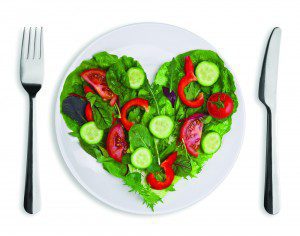

They’re that healthy. Most of us are aware of this in a general sort of way. The specifics of their healthfulness are a bit less widely known, and specifically, salads are both full of heart-healthy, cancer fighting, cell-building ingredients and are fantastic weight-loss and weight-maintenance tools.
Really, it’s hard to beat salad for slimming down. Leafy greens are one of the lowest-calorie foods out there — one cup of romaine lettuce has 10 calories, and spinach has 7. Other raw vegetables are pretty impressive, too: Red peppers, carrots, and cucumbers have 20, 17 and 8 calories per 1/2 cup serving, respectively.
If you’re aiming for weight loss, a salad can be one of the most satisfying ways to spend a couple hundred calories. It’ll cost you about as much as one large slice of bread, won’t cause a blood-sugar spike, will help prevent obesity and its health complications and will be a whole lot more filling.
It’s filling partly because vegetables contain a lot of water, but also because salads tend to be high in fiber, which makes you feel full. Some particularly high-fiber salad ingredients include beans, peas, artichoke, broccoli, and apples.
Fiber’s filling nature is only the beginning, though. It’s also one of salads contributor’s to general health: Fiber prevents constipation and can lower cholesterol levels for heart health.
Salad’s other contributors to heart health include the ever-useful antioxidants, like vitamin C in broccoli, strawberries and bell peppers; vitamin E in sunflower seeds and spinach; folate in romaine lettuce and asparagus; and beta-carotene in orange veggies like carrots and sweet potatoes. Antioxidants may also play a role in preventing cancer. One study by the American Cancer Institute found that a diet heavy in fruits and vegetables can even reduce cancer risk in smokers.
Romaine Lettuce – Salad’s Secret Punch
of Vital Nutrients
Want to maximize the health benefits of your salads? Start with romaine lettuce for a salad guaranteed to be packed with nutrients.
Not all lettuce is created equal, but if you start your meal with a salad made of romaine lettuce you will be sure to add not only a variety of textures and flavors to your meal but an enormous amount of nutritional value.
The vitamins, minerals, phytonutrients and fiber found in romaine lettuce are especially good for the prevention or alleviation of many common health complaints.
Due to its extremely low calorie content and high water volume, romaine lettuce—while often overlooked in the nutrition world—is actually a very nutritious food. Based on its nutrient richness, our food ranking system qualified it as an excellent source of vitamin A (notably through its concentration of the pro-vitamin A carotenoid, beta-carotene), vitamin K, folate, and molybdenum. Romaine lettuce also emerged from our ranking system as a very good source of dietary fiber, four minerals (manganese, potassium, copper, and iron), and three vitamins (biotin, vitamin B1, and vitamin C).
Not all Salads are Equal.
All this salad healthiness isn’t a given, though. Salad isn’t going to help you slim down if it’s got a half-pound of cheddar on it. Same goes for salads with a pint of croutons, swimming in creamy dressing, loaded with calorie-dense dried fruit or chock full of high-fat nuts.
Still, you can eat a healthy salad even if you’re not head-over-heels for the taste of spinach and straight lemon juice. Just follow a few guidelines:
Extras — Keep the high-calorie stuff light — a sprinkle of crumbled feta cheese or raisins, a tablespoon of sunflower seeds, a half-cup of croutons.
Dressing — Choose up to 100 calories of low-fat or fat-free dressing, or put full-fat dressing on the side and dip each bite conservatively. For oil-based dressings, choose healthy oils like olive or flax seed.
Protein — Keep it lean (skinless chicken, fish, or ham) and small (3 ounces is a serving).
If you’re thinking, “Sounds great — if I had the time,” you’re in luck, Saladworks serves up fresh, colorful, nutrient-dense salads every day. Stop by and grab a tasty salad creation today.
We offer over 50 toppings, 18 dressings, many lite or fat free, and our 12 signature salads have 400 calories or less before adding dressing.
2352 Pine Ridge Road, Naples, FL 34109 | 239-228-7815 | saladworks.com
 Southwest Florida's Health and Wellness Magazine Health and Wellness Articles
Southwest Florida's Health and Wellness Magazine Health and Wellness Articles
